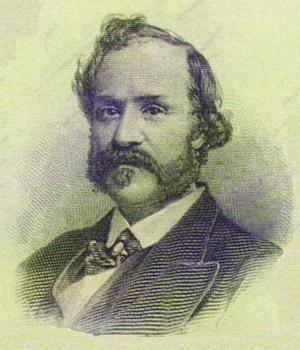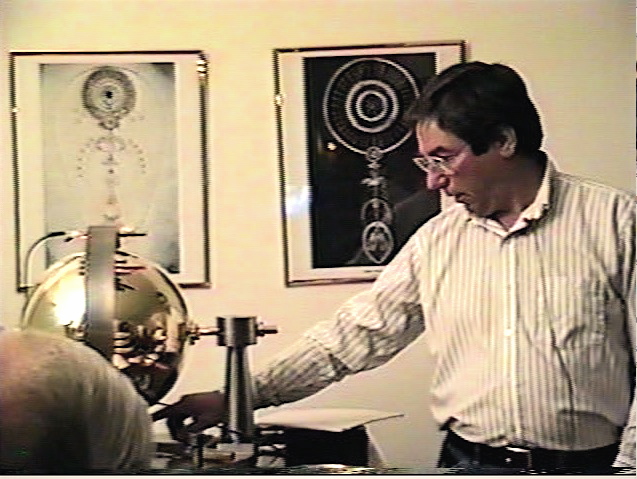| Check out the SVPwiki | SVP Cosmology 2.3 |

(1824 - 1899)
Keely's work, the work we have been enjoying, we owe entirely to Mrs. Clara Jessup Bloomfield-Moore. She financed his research and wrote prolifically attempting to interest science of her day to look at and accept his discoveries.
Mrs. Moore was a remarkable woman. She was born in Philadelphia, Pennsylvania, February 16, 1824, and was a daughter of the distinguished scientist, Augustus Edward Jessup, for many years an active member of the Academy of Natural Sciences and was part of the exploratory team to Yellowstone, Wyoming territory. She received her education partly at home and partly at the Westfield (Mass.) Academy. October 27, 1842, she married at Westfield, Bloomfield Haines Moore, of Philadelphia, who subsequently established (with his father-in-law) the well-known paper manufacturing firm of Jessup & Moore located near Wilmington, Delaware. His death in 1878 deprived Philadelphia of one of its outstanding citizens. The Philadelphia Inquirer published a long editorial, the writer of which stated that: "It was the unswerving rectitude, the untiring industry and doubtless enterprise which marked his career from first to last, that made his life of such value to his fellow-citizens and gave him his true distinction." Mrs. Moore was a prolific writer, her publications including: The Young Ladies Friend (1876), On Dangerous Ground (1876), Sensible Etiquette (1878), Slander and Gossip (1882), and Social Ethics and Social Duties (Boston: Estes and Lauriat, 1892. Copy held at Stanford Un.) Commentary on marriage, divorce, self improvement, and university education for women. Her last years were passed in London, where she was presented at the Court of Queen Victoria and associated with the greatest literary minds of England, including Robert Browning who was her greatest friend and for whom she wrote an eulogy. Her generosity enriched several institutions, including the Franklin Institute and the University of Pennsylvania (to each of which she donated $10,000 as memorials to her husband), and the Pennsylvania Museum and School of Industrial Art at Philadelphia (to which she presented her priceless art collection as a memorial to her husband, and which bears his name). She died in London, January 5, 1899. She and Mr. Moore were the parents of three children:
1. Ella Carlton (1843-1892); m. 1864 Count Carl Gustaf von Rosen, Commander-Captain, Swedish Navy;
2. Clarence Bloomfield-Moore (1852-1936); unmarried; Became renown archeologist with extensive digs and work throughout Florida.
3. Lillian Augusta Stuart (1853-1911); m. 1874 Baron Carl Nils Daniel de Bildt, Swedish Minister to Italy, and an eminent historian. (1)
MOORE, Clara Sophia (Jessup), poet, novelist and philanthropist, was born in Philadelphia, PA., Feb. 16, 1824, daughter of Augustus E. and Lydia (Moseley) Jessup. Her father, Augustus E. Jessup, was the scientist of an expedition under Maj. Stephen H. Long, which visited the Yellowstone region in 1816. He was a native of Berkshire county, Mass., and a descendent of John Jessup, who in 1635 settled in Long Island. The Moseleys are an ancient English family, mentioned in "Domesday Book," and have several branches in the United States, including that in Massachusetts, found by Mrs. Moores ancestor, John Moseley, of Dorchester, 1630. A son of the emigrant was married to Mary Newbury, of Boston, and removed to Westfield, Mass.; was a lieutenant in King Phillips war, and held other public offices. Clara Jessup was educated partly at home, partly at Westfield Academy, and at the school of Mrs. Merrick, New Haven, Conn. On October 27, 1842, she was married at her fathers old home, in Mass., to Bloomfield Haines Moore, of Philadelphia, and took a prominent place among leaders of society, literary as well as fashionable, of that city. Having much leisure time at her command she began to write for the press, contributing to newspapers and magazines verse and prose purporting to be the work of Clara Moreton. One of her early stories, : "The Estranged Hearts," received the first prize in a competition, where 400 manuscripts were submitted. Later novelettes, such as "Compensation" and "Emma Dudleys Secret," were similarly successful. Three books, "The Hasty Marriage," "The Home of Huntley and Raymond" and "Mabels Mission," were published without any name on the title page. When the civil war broke out, Dr. Bellows, of New York, president of the sanitary commission, named Mrs. Moore for the president of the womans Pennsylvania branch, which she had aided in organizing. She declined, but accepted the position of corresponding secretary, and with this important work upon her hands gave up literature for a time. She created and organized the special relief committee for aiding hospital work, and with Mrs. George Plitt organized the committees of women which conducted the great sanitary fair in Philadelphia. She also projected and aided in founding the Union Temperance Home for children. She also created and organized the Special Relief Committee which took such an active part in the hospital work during the Civil War, knowing no difference between the soldiers of the North and the soldiers of the South in its objects of aid, laying aside all feeling of sectional animosity and administering, with the hands of christian charity, alike to the suffering wearers of "the blue and the gray." After the was she returned to literary work, using, as a rule, her own name. In 1873 an anonymous article by her on etiquette, published in Lippincotts Magazine, attracted much attention and provoked much unreasonable criticism. In that year, also, she published a revised edition of one of her popular works, "The Young Ladies Friend;" in 1875, "Mission on Dangerous Ground," which passed through seven editions, and in 1878 her famous work, "Sensible Etiquette." Among her works were: "Gondalines Lessons and other Poems" (1881); "Slander and Gossip," privately printed (1882); "The Wardens Tale, San Moritz, Magdalena and Other Poems" (1883); "Social Ethics and Social Duties" (1892), and several books for children, of one of which, "Master Jackys Holiday," more than twenty editions were published. The proceeds of the sales of Mrs. Moores work were spent in aiding philanthropic institutions and individuals who were engaged in literary or scientific pursuits. Among these individuals was John Worrell Keely, the inventor, who for many years was supported by her gifts. Much of Mrs. Moores life was passed in London, especially after the death of her husband in 1878, and there, as in Philadelphia, her house was a resort for artists, musicians and authors. Mrs. Moore had three children: Clarence B. Moore, of Philadelphia; Ella, wife of Count Carl Gustaf von Rosen, first lord in waiting to King Oscar of Sweden and Norway, and Lillian, wife of Baron Carl de Bildt, Swedish and Norwegian minister in Rome. She died in London, England, January 5, 1899.(2)
(1) Ancestry of Clarence Bloomfield-Moore of Philadelphia; by Clara Jessup Bloomfield-Moore, edited by Baron Harold de Bildt, Cairo, Egypt and Milton Rubincam, Washington, D.C., circa 1940.
(2) National Encyclopedia of American Biography, 1899.
Click here for additional biographical information.
Other Works by Clara Jessup Bloomfield-Moore (pen names: Clara Moreton and Harriet Oxnard Ward):
The Adopted.
The Fulfilled Prophecy.
Renunciation.
Reasonable and Unreasonable Points of Etiquette.
Unsettled Points of Etiquette.
Miscellaneous Poems.
Stories for Children.
Three Eras in a Life.
Frank and Fanny, a Rural Story (1851)
Social Ethics and Society Duties: Thorough Education of Girls for Wives and Mothers and for Professions (1892)
Agathas Friendship: A Romance for American Society.
Character and Descriptive Songster (1877)
Sensible Etiquette of the Best Society, Customs, Manners, Morals, and Home Culture. (1878)
Tales from Aristo, retold for Children by a Lady (1879)
Nancy Lee Songster; containing a complete collection of the above artist, together with a collection of the latest and best seriocomic and sentimental songs of the day (1879)
The Diamond Cross.
Letter of Instruction to my Grandson, Clarence von Rosen (1889)
Idol Affections (1890)
Robert Browning (1890)
The Refiner of Silver (1891)
First Requisites in Physician and Nurse of the Cure of Insanity (1881)
Keely Motor and the Dogmatism of Science.
Some Truths about the Keely Motor.
The New Philosophy.
Poems.
A Chapter from the Modern Pilgrims Progress: Slander and Gossip. (1882)
The Keely Motor (1886)
Mr. Keelys Etheric Force (1886)
The Keely Motor Secret (1887)
Keelys Secrets - Etheric Force Identified as Dynaspheric Force - One Phase of Keelys Discovery in its Relation to the Cure of Disease (1888)
The Keely Motor Bubble (1890)
True Science (1890)
Keelys Contribution to Science (1890)
More Science (1891)
Keelys Present Position (1892)
Physical Discoveries of John Keely (1892)
Ether, the True Protoplasm (1893)
Keely and His Discoveries (1893)
Freedom (1893)
An Echo (1894)
Aerial Navigation: Keely and His Energy (1894)
What is Science? (1894)
A Confession of Faith (1894)
 |
||
 |